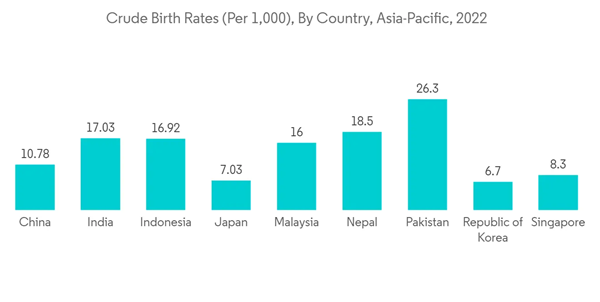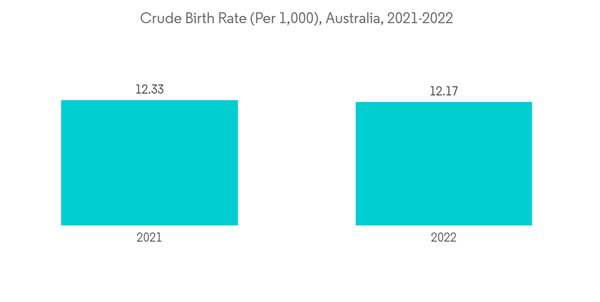COVID-19 had a significant impact on the growth of the market during the pandemic period in Asia-Pacific. This was due to the strict regulations imposed by the governments in the Asia-Pacific region leading to disruptions in neonatal care, which led to a notable impact on the market's growth. For instance, the article published by BMJ in 2021 mentioned that the pandemic affected newborn follow-up care, with 48.5% of patients reporting fewer appointments per newborn and 32.6% reporting fewer staff to conduct follow-up clinics in Asia. Such reduction in neonatal and fetal care in Asian countries during the pandemic period significantly impacted the market's growth. However, the resumption of neonatal and fetal healthcare practices after the relaxation of strict lockdown regulation during the post-pandemic period is expected to drive the market's growth over the forecast period.
The high birth rate and preterm births in the Asia-Pacific population are the major factors boosting the market studied. According to the Frontiers article published in July 2022, 52.9% of births will be preterm n Asia in 2021. the article also mentioned that India accounted for 23.4% of preterm births worldwide, China for 7.8%, Bangladesh for 4.0%, and Indonesia for 3.5% of the total preterm birth rates worldwide. Preterm babies often require special care in the neonatal intensive care unit (NICU). The demand for neonatal devices is also increasing, which is expected to be a key driving force for the studied market.
Additionally, the increasing strategies of the market players, such as collaborations, partnerships, and others, and rising launches of various awareness campaigns regarding fetal and neonatal healthcare in Asia-Pacific countries are also expected to drive the market's growth. For instance, in October 2021, Melody International collaborated with Abdul Latif Jameel Health to distribute Melody's innovative remote Melody I Mobile Fetal Monitor iCTG, a cloud-based wireless fetal monitor program across the Asian market. Also, in November 2022, the Director of Health Services at UT Ladakh launched the SAANS campaign in Ladakh to increase awareness and reduce the infant mortality rate in this region.
Thus, the high prevalence of preterm births, the presence of major market players, and rising awareness among the Asia-Pacific population are expected to fuel the market's growth over the forecast period. However, the limited accessibility and stringent regulatory procedures are expected to hinder market growth in this region.
Asia Pacific Fetal and Neonatal Monitoring Market Trends
Pulse Oximeters Segment is Expected to Hold Significant Share in the Market Over the Forecast Period
A pulse oximeter is a device used to estimate neonates' blood oxygen saturation and pulse rate. Pulse Oximetry screening is done 24 hours after birth to fully allow the baby's heart and lungs to adjust to life outside the birth mother fully. This is vital in caring for infants and children with the cardio-pulmonary disease.Factors such as the high burden of diseases among neonates and, the growing demand for early diagnosis, rising birth rates in Asia-Pacific are also expected to drive the growth of the studied segment. For instance, the article published in Frontiers journal in May 2022 mentioned that in China, the prevalence of congenital heart disease was 8.44 per 1,000 live births. Similarly, the article published in HT in August 2021 mentioned that around 84,000 children in North India are born with congenital heart disease yearly. Such increasing prevalence of cardiac disorders in neonates is expected to drive the demand for pulse oximeters for early and effective diagnosis, thereby driving the growth of the studied segment.
Additionally, the increasing birth rates in Asia- Pacific are also expected to drive the demand for pulse oximeters for neonatal monitoring, fueling the growth of the studied segment. For instance, per the WHO data published in 2022, the crude birth rate in India was 17.03 per 1,000 people; in Indonesia, 16.92 per 1,000 population; in Thailand, 9.63 per 1,000 people; and in Singapore, 8.3 per 1,000 people. Such rising birth rates in Asia-Pacific countries are expected to contribute to the rise in the demand for pulse oximeters for properly monitoring neonatal health, thereby driving the growth of the studied segment.
Australia is Expected to Hold the Significant Share in the Market Over the Forecast Period
Australia is expected to hold a significant share in the Asia-Pacific fetal and neonatal monitoring market over the forecast period owing to the rising number of births and favorable government policies and increasing awareness campaigns regarding neonatal healthcare. As per the WHO data indicators, the crude birth are in Australia in 2021 was 12.33 per 1,000 people and in 2022 was 12.17 per 1,000 people. Such a high birth rate in Australia is expected to drive the demand for fetal and neonatal monitoring devices, thereby driving the growth of the market in this country.Additionally, the rising preterm births and birth diseases are expected to contribute to the growth of the market in this region. For instance, the data published by Australian Preterm Birth Prevention in 2022, mentioned that more than 26,000 Australian babies are born preterm each year. Similarly, As per the Heart Research Institute data published in February 2022, 8 babies are born every day in Australia with congenital heart disease. Such high preterm birth rates along with increasing congenital heart diseases are also expected to drive the demand for fetal and neonatal monitoring to reduce the mortality of newborns, thereby driving the growth of the market in this region.
Additionally, the increasing market player strategies such as partnerships, collaboration, and agreements to launch various fetal and neonatal monitoring programs in Australia are also expected to propel the growth of the market. For instance, in April 2021, HeraMED signed an agreement with Joondalup Health Camps in Western Australia to incorporate a paid pilot of the HeraCARE digital pregnancy monitoring platform. HeraMED provides pregnant mothers with fetal heart rate monitors, allowing expectant mothers to monitor their baby's heart rate at home and doctors to remotely monitor the mother and child.
Hence, owing to the aforementioned factors, such increase in the birth rate, rising preterm births, and the presence of key market players the studied market is expected to witness growth over the forecast period in the country.
Asia Pacific Fetal and Neonatal Monitoring Industry Overview
The Asia-Pacific fetal and neonatal monitoring market is fragmented, with several players. Some strategies include agreements, collaborative models, business expansion, and product development. Some of the major players are Draegerwerk AG & Co. KGaA, FUJIFILM SonoSite Inc., Medtronic Plc, and Koninklijke Philips NV.Additional Benefits:
- The market estimate (ME) sheet in Excel format
- 3 months of analyst support
This product will be delivered within 2 business days.
Table of Contents
Companies Mentioned (Partial List)
A selection of companies mentioned in this report includes, but is not limited to:
- Atom Medical Corp
- Becton, Dickinson and Company
- Medtronic Plc
- GE Healthcare
- Natus Medical Incorporated
- Koninklijke Philips NV
- Draegerwerk AG & Co. KGaA
- FUJIFILM SonoSite Inc.
- Siemens Healthineers
- CooperSurgical Inc.
- Pheonix Medical Systems Pvt Ltd
- Cardinal Health










